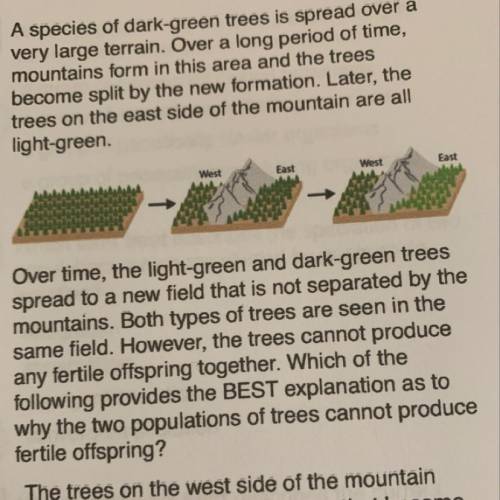
Biology, 14.07.2020 20:01 rbrummitt8029
A species of dark-green trees is spread over a
very large terrain. Over a long period of time,
mountains form in this area and the trees
become split by the new formation. Later, the
trees on the east side of the mountain are all
light-green.
Over time, the light-green and dark-green trees
spread to a new field that is not separated by the
mountains. Both types of trees are seen in the
same field. However, the trees cannot produce
any fertile offspring together. Which of the
following provides the BEST explanation as to
why the two populations of trees cannot produce
fertile offspring?
A. The trees on the west side of the mountain
retained their original phenotype that became
unique to their population.
B. The trees on the east side of the mountain
developed a new phenotype, which made them
unable to produce fertile offspring.
C. The trees on the east side of the mountain
experienced many genetic mutations and
recombinations unique to their population.
D. The trees on the west side of the mountain
could not adapt to the new barrier, which made
them unable to produce fertile offspring.


Answers: 3


Another question on Biology

Biology, 22.06.2019 09:00
Which of these is an example of land degradation? a. containers designed to store pollutants leak. b. fertilizers provide too many nutrients to crops. c. garbage is buried so the land can be reclaimed later. d. a drought kills all the plants in an area, leaving bare land
Answers: 3

Biology, 22.06.2019 12:00
When the oxygen produced by photosynthetic plants in the water dissolves in the water, which of these is being formed?
Answers: 1

Biology, 23.06.2019 00:00
What is the correct name for the animal pictured on the right? puma cougar panther mountain lion catamount
Answers: 1

Biology, 23.06.2019 05:00
Asap 1. what happens to particles when a substance gains energy and changes state? 2. what happens to the energy that is lost when water freezes? 3. how does the movement of particles in a stick of butter differ from the movement of particles in a dish of melted butter? 4. as water is cooled, at what temperature do its particles become fixed in place? 5. how do evaporation and boiling differ?
Answers: 1
You know the right answer?
A species of dark-green trees is spread over a
very large terrain. Over a long period of time,
Questions


Mathematics, 16.10.2019 17:30

Mathematics, 16.10.2019 17:30

History, 16.10.2019 17:30


Social Studies, 16.10.2019 17:30

English, 16.10.2019 17:30




Health, 16.10.2019 17:30

English, 16.10.2019 17:30



Physics, 16.10.2019 17:30




Mathematics, 16.10.2019 17:30




